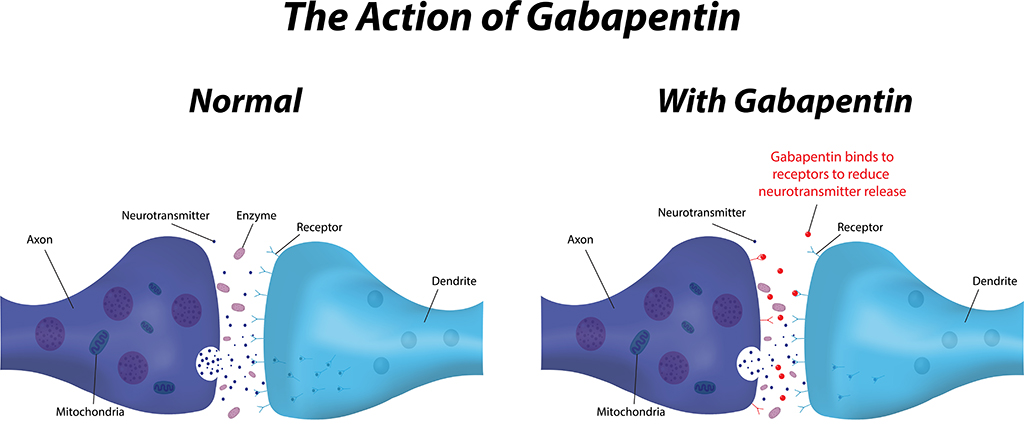
Reviewed By: Barbara Rexer, DSW, LCSW, LCADC, CCS, ICCS, DRCC
If you suffer from nerve issues or certain kinds of pain, your doctor may have prescribed a drug called gabapentin. With a low potential for abuse or risk of addiction, doctors sometimes consider it a safe alternative to opioids. However, that doesn’t mean it doesn’t come with risks. Here’s a look at how gabapentin works, the potential side effects, and other important details.
What is Gabapentin?
One of the most commonly prescribed medications in the United States, gabapentin is an anti-epilieptic drug that also treats nerve pain. Doctors also prescribe the drug, also known as brand-name Neurontin, to treat restless leg syndrome. Some doctors even use the multi-purpose drug to treat alcohol and cocaine withdrawal symptoms.
The structure of gabapentin is similar to the brain chemical gamma-aminobutyric acid (GABA), which affects the nervous system. In some people, the medication produces feelings of calm and relaxation.

What Are the Side Effects?
Gabapentin has the ability to slow many body functions. This leads to a number of side effects, including:
- Dizziness
- Drowsiness or tiredness
- Poor coordination
- Tremor or shaking
- Vision changes (blurriness, double vision, unusual eye movements)
Some patients experience trouble breathing, which can lead to coma or even death. Others have reported feelings of depression, mood disorders, and suicidal thoughts or actions.
Have questions about addiction?
Call us at 855-430-9426 to speak with a recovery specialist.
What is the Potential for Abuse?
While gabapentin is considered less addictive than opioids, gabapentin abuse does occur. Individuals who struggle with opioids are most susceptible to gabapentin addiction. However, anyone could develop problems with the medication.
Gabapentin can also produce an intoxicating effect. Users describe the high as similar to marijuana, creating a sense of calm or euphoria. In some cases, problem users combine gabapentin with other substances, such as opioids, in an attempt to augment their high. While intoxicated, users appear sedated. It is important to note that research on the long-term abuse of gabapentin is limited, and many of the dangers related to habitual use remain unknown.
Stopping gabapentin can lead to a number of withdrawal symptoms, including nausea, headaches, trouble sleeping, irritability and anxiety.
Dangers of Mixing Gabapentin and Other Drugs
Mixing gabapentin with other substances can lead to a number of negative effects. Mixing the drug alcohol, for example, may increase the odds of respiratory distress.
Taking the drug with benzodiazepines increases breathing issues and may cause extreme drowsiness. In some cases, these respiratory issues can lead to coma or death.
Taking gabapentin with opioids that slow the digestive tract, like morphine, allows for more absorption of the gabapentin. This could also increase the chances of adverse side effects.
Have questions about getting help?
Call us at 855-430-9426 to speak with a recovery specialist.
Alternatives to Gabapentin
Although gabapentin is popular — it has become the fifth most prescribed medication in the United States — doctors can often prescribe alternatives for the ailments it treats. Lyrica, which is also in the gabapentinoid drug class, is one common option for nerve pain and seizures. However, Lyrica also carries with it some significant risks, including potential for abuse.
Tegretol is a medication that is commonly prescribed to treat seizures and certain types of nerve pain, specifically diabetic neuropathy or trigeminal neuralgia. It may be a viable alternative to gabapentin in some situations.
For issues like restless leg syndrome, doctors can sometimes recommend more natural remedies, such as moderate exercise and a diet rich in iron.
How to Seek Help
If you are addicted to gabapentin or other substances, you don’t need to struggle alone. With an inpatient treatment program or intensive outpatient program, you can recover in a supportive, temptation-free environment designed to help you recover for life. Since some of the withdrawal symptoms of gabapentin can be unpleasant, an intensive program also ensures you will have access to daily medical care when you need it.
Beyond intensive treatment, professional treatment will also give you the tools and support you need to make a healthy transition as you start life in recovery.
Have questions about addiction?Chat with one of our recovery specialists now.

Written By: Sprout Editorial Team
The Sprout Health Group editorial team is passionate about addiction treatment, recovery and mental health issues. Every article is expert-reviewed.